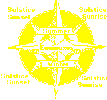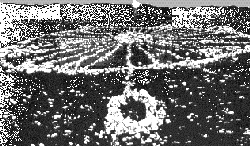

StoneWheels And Dawn Stars Rising


StoneWheels And Dawn Stars Rising
 |
 The left photo, taken from the air in the 1950's shows the rock outlines of wheel and 28 spokes, cairns, and directions. In the right photo shot from behind the outlying sunsight cairn we're looking northeast along the extended spoke at a just-risen sun. |
|---|
|
The windrose's shape is similar to early sundials and is somewhat similar to medicine wheels. (One medicine wheel in Alberta was very early named as Sundial Hill on Sundial Butte, east of Carmangay, Alberta; it has been vandalized somewhat, and now consists only of a pair of spokes that mark out a sort of "passageway" in toward a central cairn. The passageway is said to be oriented to the summer solstice sunset, if reported correctly, sunrise if they got the directions reversed, as I noticed many anthros, trying to deal with maps and diagrams, did in reporting on the Bighorn Wheel. Stones, stars, the directions, time -- these can speak to us out of an otherwise mostly silent past. Sometimes their language is intuitive, spiritual, meanings or awe will be felt by the sensitive, but can't really be communicated. But when scientists, rather than anthros, get interested, the cosmos speaks, and they can hear it through mathematics. What may have been lost in the mists of time can be found again.
After discovering a large, crude cairn-and-rays that were oriented to summer solstice sunrise at over 11,000 feet on the Continental Divide, he became interested in what pre-contact aboriginal native people of the area might have known of astronomy. It occurred to him that the Bighorn and other medicine wheels might have been observatories. He needed to make a more careful site survey and measurements than many past visitors, anthros, archaeologists, government types, tourist hype artists, had done. He needed to get exact angular measurements for sighting cairns and spokes of the wheel, in order to make computations about the stars of the past. Later, Dr. Eddy recalled the experience.... "Unravelling the case was a family adventure," he later wrote. "My wife Marjorie and our four children would help me make the survey in June, a few days before the summer solstice of 1972. But when we awoke on our first morning in the Bighorns, our hearts sank. During the night, 10 inches of snow had fallen. The 30-mile road to Medicine Mountain was closed. But the sun likes the Bighorns, and within a day, we picked our way to the top. A surprise awaited. The old rock wheel was clear of snow -- scoured by the winds that sweep the mountaintop and bleached by a high sun that knew it was summer. Together we measured the cairns and wrote down the numbers that would tell the secret of the wheel. A distinctive lonely cairn that lay at the end of a spoke outside the rim marked a line with the central hub that would point to the exact point of sunrise on the first day of summer. "In darkness the next morning we trudged up the snowy slope again. We followed our own cold trail in boots still wet from the day before. Three hours later, as a pink sky slowly brightened, we crouched nearly frozen behind the lonely outer cairn and awaited the coming sunrise. The direction of the first glow told us we could not be far wrong. And then, in majestic quiet, the great red ball of the sun appeared, exactly in line with the cairns. In the biting cold, we felt happily warm. For how many summers since the wheel was built had the sunrise moved all along the horizon to perform this striking solstice spectacle -- with no one there to watch? "How many had known what we now knew? Was it the secret of a few, who climbed the trail, as we did, to note the time of solstice, when, as the Indians noted, 'the sun is highest and the growing power of the earth is strongest'? Did it signal the sun dance with a message from the sun itself? Perhaps this medicine wheel and others like it were models for the sun-dance lodge -- instead of the other way around.
After Dr. Eddy had observed that the solstice sun lines up with the sunsight and central cairn, he wondered what the other cairns were for. He knew that many cultures gave special importance to heliacal or dawn-rising of stars. This occurs when a very bright star (first magnitude) just clears the early dawn horizon to flash briefly in the deep blue lightening sky from which all other, lesser stars have disappeared, then quickly disappears itself, as the sun rises further and the sky brightens. A heliacal rising can last at most 15 minutes. Heliacal star-risings at given latitudes are a good method of dating -- plus or minus a couple hundred years. They do not continually recur year after year because of the precession of the equinoxes, whose cause and effects we've already looked at. That has to be calculated. Other factors that have to be used in calculations are the altitude, dip angle between sites and horizons, and thickness of the atmosphere at and below the horizon, which bends light upward. It is particularly important to take into account especially latitude (44°49.6') and longitude (107°55.7') of the place where the sun and stars are seen to rise. Exact centering -- though this could have been done with cairn-centered poles -- isn't required for heliacal risings. The cairns would serve as fine "landmarks" for the positions an observer ought to watch for along the horizon just as the stars all faded. Combining these factors, Eddy calculated that any dawn-rising stars visible at the Bighorn wheel must be about 11° ahead of the sun. What bright stars could be observed rising this way, during solstice, at the Medicine Wheel? None now. But he calculated that the bright star Aldebaran (located in the constellation of Taurus, and in the Lakota sacred circle, lying on the Animal's backbone between its ribs and head) rose heliacally at the summer solstice in such a position that its momentary flash could be sighted from star cairn F through cairn A roughly in the period from 1500 to 1800 AD, with 1700 the most likely date. This gave him an approximation as to when the wheel might have been built: around 1700. That tallies well with a piece of tree branch that archaeologist D.C. Grey had found, excavating the central cairn in 1958. Grey had dated the wood, and found that it had grown until around 1760. Of course that doesn't mean it was placed in the central cairn when built, the cairn also contained beads that were 19th century and flakes and projectile points of obsidian that are much earlier. Next: Stone star computers built by Natives (mostly in Alberta) 2,200 years ago. CREDITS:Black and white photos of the Wheel were furnished to me in 1978 by the Lovell office of the US Forest Service; they were taken just before or just after World War II. Tere was no further info about them. Color photo of Dr. Eddy on Medicine Mountain checking his calcs just at dawn with a flashlight was taken by Thomas Hooper in 1976 for National Geographic magazine. Hooper also took the color photos of Venus rising heliacally over the wheel, and the solstice sun coming up aligned with its cairns. Quotes from Dr. Eddy are also from his article. The diagram of the windrose-compass was adapted from a reconstruction of that used by the ancient Greek-Egyptian astronomer-mathematician Eratosthenes, published in The Story of Maps, Lloyd A. Brown, Bonanza Books (Little, Brown & Co) NY: 1959. Note its similarity to the traditional Lakota star quilt pattern. The quilt's star will be the compass windrose at the equator, where winter and summer solstice sunpaths are equal distances from the equatorial path at the equinoxes. Of course the quiltmakers didn't know this, scientifically. But there are intuitions that tell us when a design is good or pleasing, and those might derive from how things are in the natural world in more subtle ways than replications of visual patterns. They might show, instead, the workings of natural laws, as the windrose does. |
|---|

Custom Search
|
Works |
Menu |
MENU |
|---|
Page prepared by Paula Giese , text and graphics c. 1995, 1996
Last updated: Tuesday, July 09, 1996 - 6:15:35 AM